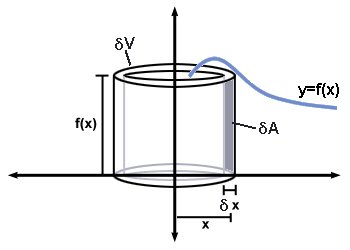How do you use the method of cylindrical shells to find the volume of the solid obtained by rotating the region bounded by #y =2/x#, y=0, x(1)=1 , x(2)=6 revolved about the y-axis?
1 Answer
Explanation:
If you imagine an almost infinitesimally thin vertical line of thickness
#delta A ~~"width" xx "height" = ydeltax = f(x)deltax#

If we then rotated this infinitesimally thin vertical line about
#delta V~~ 2pi xx "radius" xx "thickness" = 2pixdeltaA=2pixf(x)deltax#
If we add up all these infinitesimally thin cylinders then we would get the precise total volume
# V=int_(x=a)^(x=b)2pixf(x) dx #
So for this problem we have:
# V = int_1^6 2pix(2/x) dx #
# \ \ \ = int_1^6 4pi dx#
# \ \ \ = 4pi \ int_1^6 \ dx#
# \ \ \ = 4pi[x]_1^6#
# \ \ \ = 4pi(6-1)#
# \ \ \ = 20pi#

